Fashion and Religion
A conversation between the editors of the book “Silhouettes of the Soul”
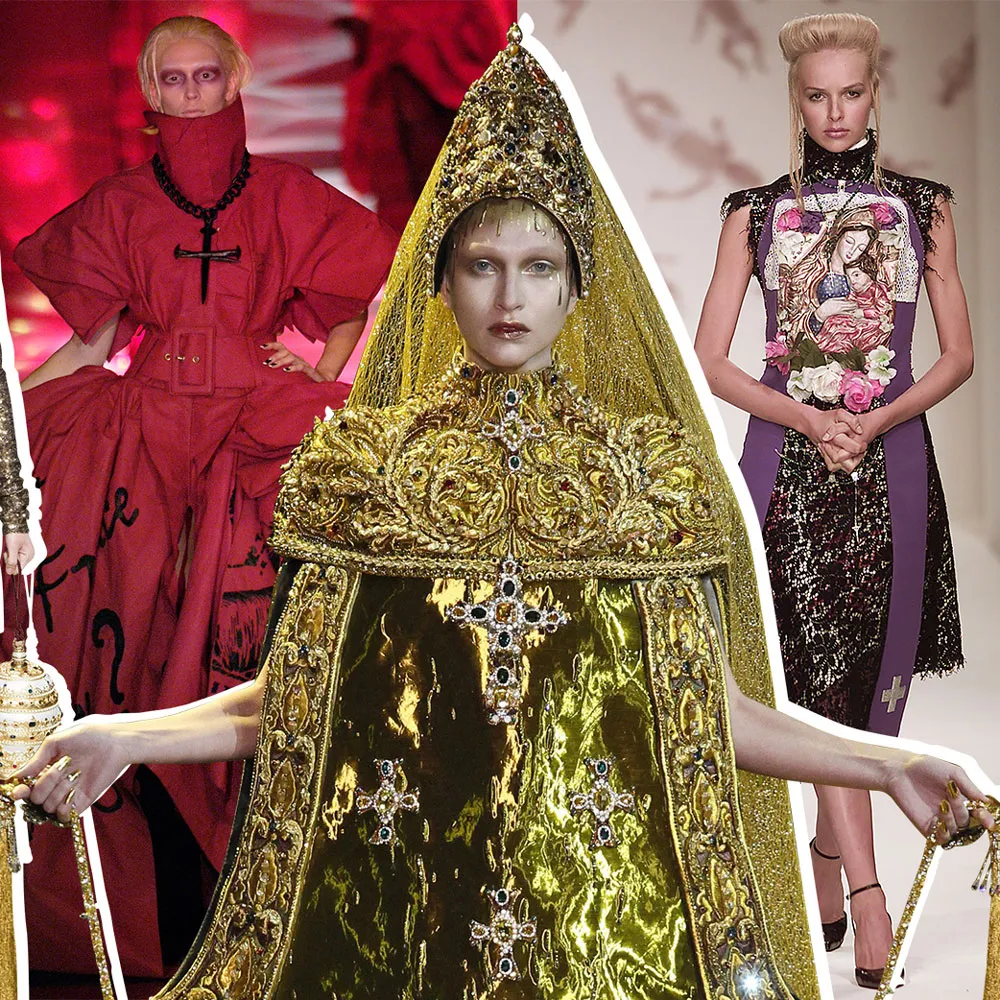
(Image source: Vogue)
The interplay between religion and fashion has long been a matter of public fascination. There are the obvious examples of religion inspiring fashion design, such as the Fontana sisters’ “Little Priest” dress (1955), the religious mosaics that adorned Dolce & Gabbana’s fall/winter 2013-14 collection, or the trending of modest fashion looks across global markets, such as ASOS Design pairing a pantsuit with a headscarf in its online catalog. The spectacle of religion-as-fashion draws quite the crowd, witnessed by the Metropolitan Museum of Art’s 2018 Heavenly Bodies, the most visited exhibition in the museum’s history, or the constant reel of coverage for Kanye West’s Sunday service at Paris Fashion Week 2020, where, as Steff Yokta put it, “all the prophets of fashion assembled.” And the religious establishment is not as ambivalent to fashion as one might assume. Although Pope Francis made quite the show of austerity with his rejection of Prada footwear at the beginning of his tenure, the Vatican did not hesitate to lend sacred artifacts to the Met’s Heavenly Bodies exhibition.
But what is beneath the surface of these highly visible displays of affection between religion and fashion? How does what we wear matter for accessing the sacred, shaping our deepest longings and convictions, seeking belonging or embodying dissent? What is at stake personally, politically, and spiritually in how we dress?
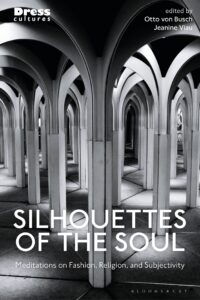 These deeper questions are at the heart of our collaboration between a designer and a theologian and the various projects that we collected in our edited volume Silhouettes of the Soul: Meditations on Fashion, Religion, and Subjectivity, which comes out in paperback this August with Bloomsbury Academic. The book challenges traditional religious and academic views. Along these lines, we ended each book section with an interview, which helped us bring in alternative voices, such as LGBTQ+ activist, monk, and makeup artist Kodo Mishimura. With the release of the paperback, we decided to revisit some of the collection’s themes, especially in light of recent religiously driven legal suppression of dress freedoms throughout the United States.
These deeper questions are at the heart of our collaboration between a designer and a theologian and the various projects that we collected in our edited volume Silhouettes of the Soul: Meditations on Fashion, Religion, and Subjectivity, which comes out in paperback this August with Bloomsbury Academic. The book challenges traditional religious and academic views. Along these lines, we ended each book section with an interview, which helped us bring in alternative voices, such as LGBTQ+ activist, monk, and makeup artist Kodo Mishimura. With the release of the paperback, we decided to revisit some of the collection’s themes, especially in light of recent religiously driven legal suppression of dress freedoms throughout the United States.
The following conversation was recorded via video conferencing and edited for clarity and depth.
***
Jeanine Viau: I thought it might be helpful at the start to talk about how both of us became interested in the relationship between religion and fashion, and how our experiences reveal why we think this conversation matters. I think back to my dissertation research with LGBTQ+ student activists at Catholic universities.
In almost every interview, these activists talked about how their personal aesthetics and attire help them explore their identities and experiences, express themselves, and think through who they are and what they desire. In addition to the campus programs they were creating – vigils, poetry readings, workshops, drag shows – what was also important to them was what they were wearing every day and how fashioning themselves becomes an intervention in the world.
They also had profoundly traumatic experiences related to clothing, such as bullying in their homes, in their schools, and in their religious spaces. One, for example, recalled a moment in Target when he chose a red t-shirt and his dad said no and used a homophobic expletive to describe the color red.
Hearing their stories, I was reminded that clothing is an issue of life and death, that fashioning oneself in the world is not a superficial thing. Learning about the power of dress inspired me to teach a class on fashion and social ethics where students examine and connect their personal longings and creativity to collective movements.
Otto, this is when I found your work.
I was really energized by the union of the personal and the political in your approach to design and teaching. Your definition of clothing as “the conflict-ridden interface” between human beings’ souls and the public realm offers a compelling starting point for discussions with my students and for us, you and me and the contributors to the book, to start thinking about the deeper dimensions of dress.
So, I want to ask you, when did you start thinking about religion and fashion?
Otto von Busch: I started approaching fashion from practice. I was sewing and altering clothes. And then I wrote my master’s thesis about fashion advertising. I was using the classical toolbox that academics taught me, most of it coming out of art history, with a focus on semiotics, or the study of signs and symbols. But I felt frustrated with that language. While it made sense analytically, it didn’t really help articulate a designer’s perspective or work.
I had long held an interest in alchemy, and there was something there that I found fascinating about the transformation of turning lead to gold, but also that the process of alchemy was about a corresponding inner transformation. The concepts and mystical framework around alchemy captured the idea that the transformation of fabric into fashion is something that is more than just a signifier, and there exists a more profound connection between the materiality of garments and the inner workings of our lives and emotions.
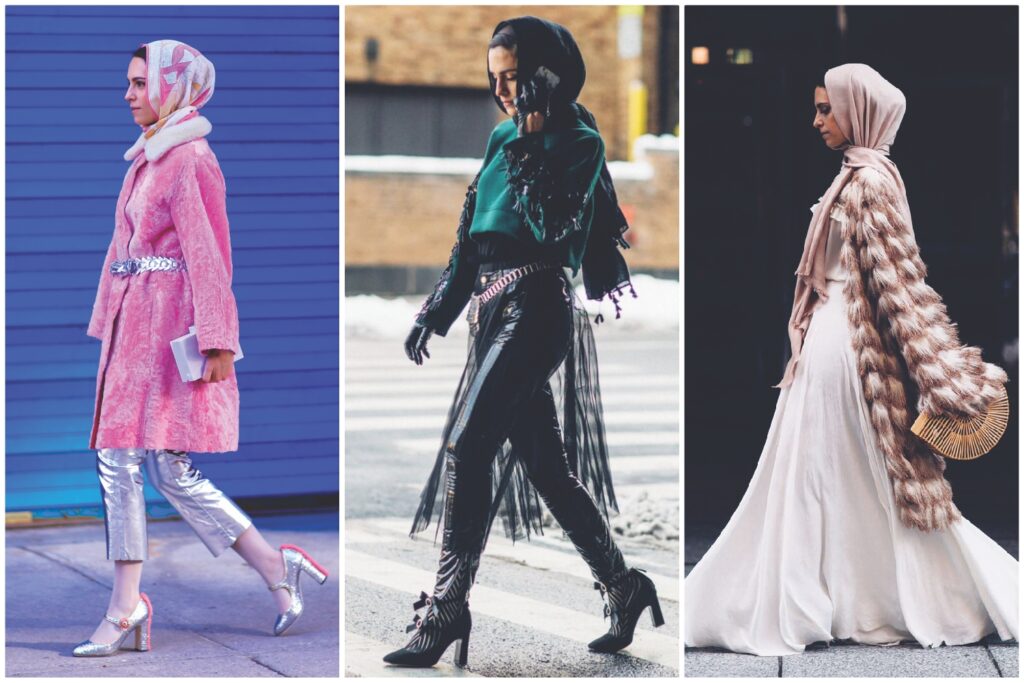
(Three examples of modest fashion. Images by @mademoisellememe on Instagram for Los Angeles Magazine)
I had felt held back by typical academic language, where fashion was primarily a form of communication, if not outright delusion or propaganda, and where the messages are already existing, ready to be transmitted by what clothes we wear. I was searching for ways to understand fashion as much more of an inner transformation, that the reasons we do care about how we dress is because it matters more deeply to us. In many ways, getting dressed can be a leap of faith – you put some inner aspects of yourself out there to be judged by others. Like any real transformation, it is a risky business.
JV: I really like this idea that an alchemy between religion and fashion, the mystical and the material, might move us beyond the limits of our academic toolboxes to something both deeper and more accessible. Along these lines, I want to ask you about defining fashion. You reference the concept of fashion as language. Other definitions, like those of Elizabeth Wilson and Joanne Entwistle, insist on defining fashion in relation to modern capitalism in the West.
But, reducing fashion to a phenomenon of modern capitalism is too limited for what we’ve attempted to do with the book and in our dialogues. As you say, these definitions will not provide the language or the techniques we need.
I wonder then how do you define fashion in a way that’s expansive enough for it to do the work that you just talked about?
OvB: Throughout my work, I’ve usually fallen back on a definition by the Swedish fashion journalist Suzanne Pagold, that “fashion is to dress like everyone else, but before everyone else.”
It’s a simple and playful way of defining fashion, pointing to it as an everyday phenomenon. It is not dependent on capitalism or the fashion system. It could exist in every culture, and it can thus be found, to some degree, in every cultural expression. So, fashion is commonly dispersed. It is about having a look before everyone else, but also to make sure that it’s not the wrong everyone. Take, for example, when a child comes from school and says that “everyone” has this or that garment. She doesn’t really mean everyone at the school, but everyone who matters, which are just a handful of people. But they are the important ones, the ones she looks up to.
This definition makes fashion a social phenomenon. And it is a useful definition as it bypasses the necessity of an industrial system of garment production, or capitalism, or media and celebrities, or most of the cultural components we may think are the center pieces in the way fashion operates.
But at the heart of it, I think fashion must also be defined by our yearning for connection. We, as humans, are wired to connect with others. We are born dependent on others to live. This need is also at the heart of fashion. This is also what makes the fashion industry so extremely powerful, that fashion manages to tap into a deep desire within us. Our hunger to belong. So, when fashion really works for us, it connects at a level beyond mere everyday communication. It is not merely a signal; that I am this or that. No, when fashion really works, someone sees something in us that we haven’t put in words, and someone acknowledges something unspoken within us. We see each other, and recognize each other, on a deeper level.
When this works, it is an extremely powerful revelation of two or more subjects meeting each other beyond words, affirming and energizing each other, adding vitality to each other’s lives. And this experience can be totally transformational. We can feel reborn. This is no small thing, not just a delusion or capitalist conspiracy.
JV: Yes, there is an aliveness to clothing and a dynamic of intelligibility, or revelation, as you say, that goes beyond what can be said. It’s more than just, “I have a slogan on my t-shirt.” It’s the texture of a person.
I am sitting here noticing and remembering what kinds of fabrics people choose. There’s a sense of feeling them in the relationship between who they are, what their affect is in the world, and what textures they choose to put on their bodies. And those textures are interfacing with others who are touching them or imagining touching them. It’s like touching the interior of a person sometimes, right?
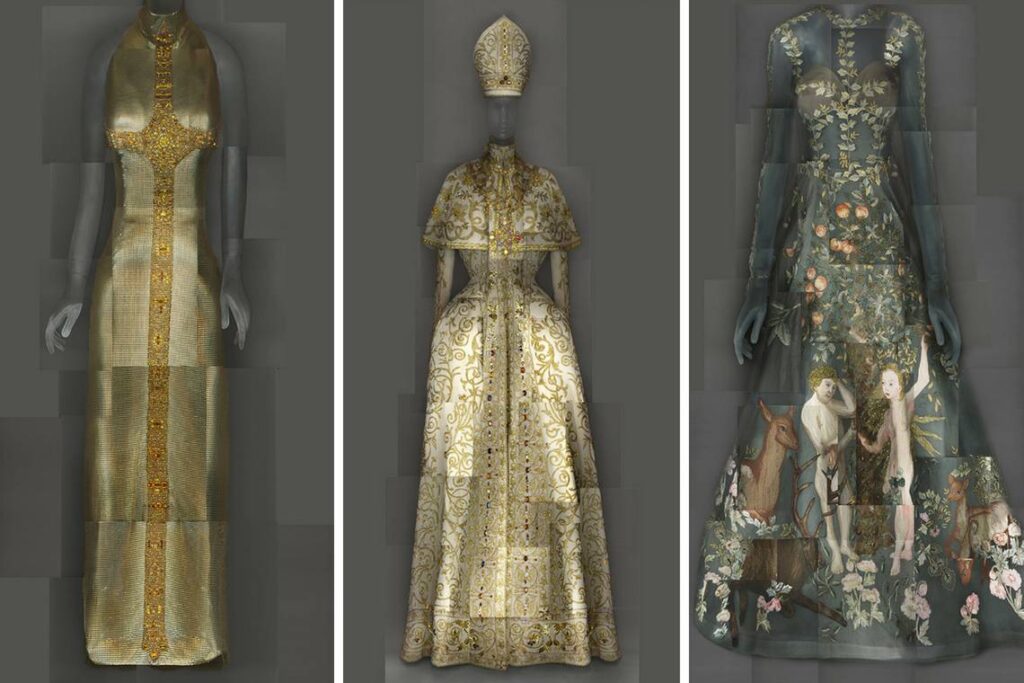
(Image source: Metropolitan Museum of Art)
I remember the first time we met and how impressed I was by the finely tailored, leather kilt you wore paired with a spare and elegant white shirt. I thought, “He is a Viking, literally.” Also though, the suppleness and movement of the leather showed the softness and flexibility of your interpersonal style, how hospitable and supportive you are.
Going back to Pagold’s definition of fashion, “to dress like everyone else, but before everyone else,” one thing I think that fashion does for religion, or why it matters to religion, is it really helps religion take itself less seriously in a way that makes it more serious. Engaging with fashion reminds religion of its own creativity and innovation. In a way, fashion gifts that to folks who are practicing or thinking about spirituality.
You mention the yearning for connection and belonging. This is really important in religion as well, but often belonging in religion is thought to come through conforming – to dress like everyone else, after everyone else. The biggest concern is carrying through the tradition, to worship or believe or practice like everyone else in a long lineage of practice and belief and worship.
But it doesn’t really work that way. Religion is constantly evolving. It is always creative, always responsive to and interacting with context, with society, with politics, with art, with expressions of beauty. Religion is made out of the conditions, materials, and ideas that are available to it in the moment.
When you said fashion is to dress like everyone else, just before everyone else, I immediately thought of the prophetic tradition in Judaism, Christianity, and Islam. To be prophetic is to think differently about what’s going on before everyone else is thinking about it. That is religion. That is what drives religion forward and continues to make it relevant, continues to convict people over and over again. People are recreating or creating new religions all the time. Young people and those on the margins of established practices are especially drawn to this freedom. They’re piecing together new things with the old, and that’s really exciting.
Sometimes in traditional religious studies and traditional religious communities, there’s a resistance to that, and even a denigration of that kind of creativity and evolution. Bringing fashion into a conversation with religion gives religion back its prophetic imagination, this consciousness of its own creativity, its own aliveness.
Religion is still alive. It’s not just a tired, old-fashioned pattern that we pass hand to hand and replicate, what Donna Haraway calls “the sacred image of the same.” Religion is a living, breathing thing that emerges from ourselves and that we put on our bodies and that gives us the courage to write new songs and poems and dance together.
OvB: Yes, I think this connection between fashion and religion appears in the two aspects of time the Greeks used: Kairos versus Chronos. Kairos is of the moment while Chronos is what we best know as the chronological, or chronic. A passion is of the moment, it cannot be chronic, and this emotional fire is an aspect of Kairos. Similarly, fashion is a passion and of the moment. On the other hand, style, dress, dress history, and where we may usually think of religious forms of dressing, are aspects of Chronos, expressions that endure over time. Kairos and the fashion of the moment are always of the now, and they have this promise of something to come, something that is just about to happen. And this is its prophetic potential.
The prophetic is what captures the moment, suggests something about the future, yet does so by articulating something that makes sense right now, using the language and images of the time. And this is how fashion works in our experience. Take for example, I come into a store and find a suit jacket, and it just feels there is something there, it reveals something to me. It may be how I would want to look a little bit like my father, or the image I have of him. Of course, the designer doesn’t know my father and knows nothing about this aspect of my life. But it is not the old jacket, but one of today, and I can see something in that jacket that just makes sense and captures some form of longing that speaks the aesthetic language of the day. This jacket puts a shape, or a silhouette, to an unspoken yearning in my inner life. And I can buy this object, and wear it, and make it mine.
In such occasions, the designer acts as a prophet of the moment and lights the way to a time to come. The look may share the zeitgeist, the “geist,” the spirit, or the aliveness of the current moment. And again, coming back to where you started, this is where fashion can come to express a deep, inner yearning, to connect to others and express something that means so much to them. Here fashion gives people a means to connect, just like poetry, music, or art, that probes and reveals a depth of the human soul.
JV: Yes, and circling back to fashion as a matter of life and death, my research with student activists began in 2010 during a surge in media attention to LGBTQ+ youth suicides and bullying, including Dan Savage’s It Gets Better campaign, which encouraged gay young people to wait out the hate and violence, and find other spaces of belonging. But how long do we have to wait? How many of us will die or lose our livelihoods or our faith before bullies, politicians, concerned parents, and faith leaders pay attention to new prophets?
Now, over a decade later, I teach and mentor trans and non-binary students in Florida, which has passed several laws prohibiting gender affirming care for young people and expanding laws that make public drag performances illegal. Instruction on gender identity and sexual orientation is now prohibited in grades K-12 in the state.
Why does fashion matter here? Because trans, non-binary, and gender non-conforming people are afraid to be themselves in public. Because we are living in a state where those in power are enforcing a religiously driven fascist policing of dress.
And this is not just a trans or non-binary or queer issue, not to disengage from the exceptional vulnerability of these folks, but prohibiting drag in public makes anyone whose personal style does not conform to a sex-gender-matchy-matchy uniform subject to sanctions. It wasn’t so long ago that public decency laws in America criminalized women for wearing trousers.
Recently, my mom told me how in 1970 she and her high school classmates organized a protest against the requirement that women had to wear skirts to school. They all wore pants to school on the same day and the policy changed. Sadly, the Catholic school that my parents sent me to only allowed girls to wear pants a few years ago.
Why are we so quick to forget our prophetic courage? Why do we continually revert to the false certainty of rules? Religion, I think, is still more rigid in what the rules are and who is authorized to make them. Fashion is more fluid. Fashion, I think, celebrates dissent in a way that religion needs at this moment. Lives depend on it.
OvB: Yes, I think we’re seeing this hierarchization of fashion in the emergence of new Haute Couture exhibitions at highly regarded cultural institutions. Take, for example, Heavenly Bodies at the Met. Here we could see Italian Haute Couture mixed with relics and the finest art of the Catholic Church, and it revealed how today’s belief systems easily intermix religious artifacts with the artifacts of the fashion system. I think this exhibition really caught on a certain reverence for the elevation and hierarchization of not only society at large, but of desires and the search for meaning in institutions too.
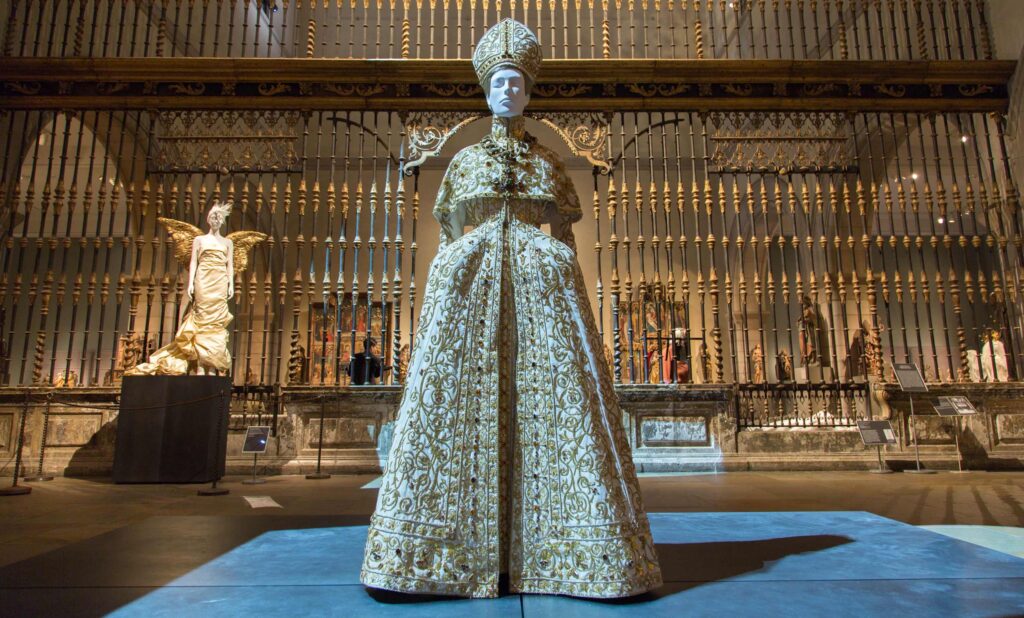
(Heavenly Bodies exhibit at the Metropolitan Museum of Art)
But most importantly, the exhibition only focused on institutional types of fashion and belief. It did not capture the prophetic. While it may be pretty to view, it does not recognize where fashion really happens. It ignores everyday faith. The passion, the fire, of the prophetic is missing. Nothing is really at risk here.
In many ways, fashion is like music. It happens inward as much as outward. Think of a concert, where people move together to the tune of our time. There is a synchronization of movement and attention toward the performer but also to the others in the audience. By sharing the experience, we are together, and it produces this fantastic emotional sense of togetherness. We connect with each other around certain tunes and the excitement around our shared fandom. We come together in a common passion and in this rich emotional attunement. We become larger than ourselves. Just think of a love song that really works. It breaks our sense of isolation, that we are the only ones who suffer from a heartbreak. The emotional connection, singing it together, embracing these emotions of heartache, sharing it, that engages more than just language are more than just simple words. My whole body tunes into my inner yearnings and unfulfilled hunger for love. Garments, in a similar way, connect us together. I wear these clothes, but they are also part of a larger experience, attuning me and my yearnings to others.
I think this is what got me so fired up with our book, that fashion is part of a human phenomenon that religion is well accustomed to, and has rich languages and traditions to help us unpack. It has rituals and practices, in all kinds of different facets across cultures in the world, that tap into the deep yearnings of the soul and give them a shape that we can share together, bringing us closer to these experiences but also to each other.
At best, fashion is almost a mystical experience. A one-ness of sorts. It exposes us to all the different silhouettes of the soul. For those interested in reading more about different approaches to the relationship between religion and fashion, the anthology Silhouettes of the Soul is available to preorder in paperback from Bloomsbury Academic.
Jeanine Viau is Associate Lecturer of Religion and Cultural Studies at the University of Central Florida.
Otto Von Busch is Associate Professor of Integrated Design at Parsons School of Design.